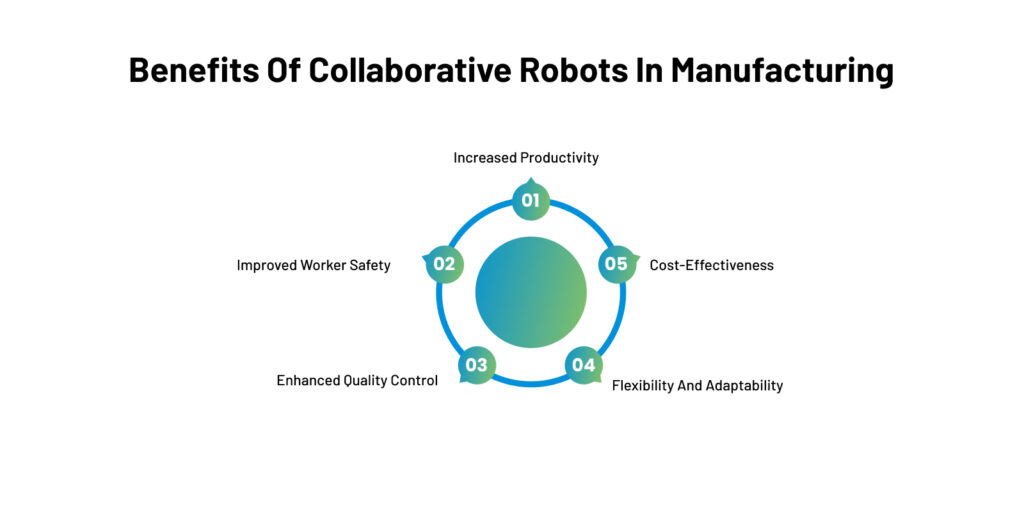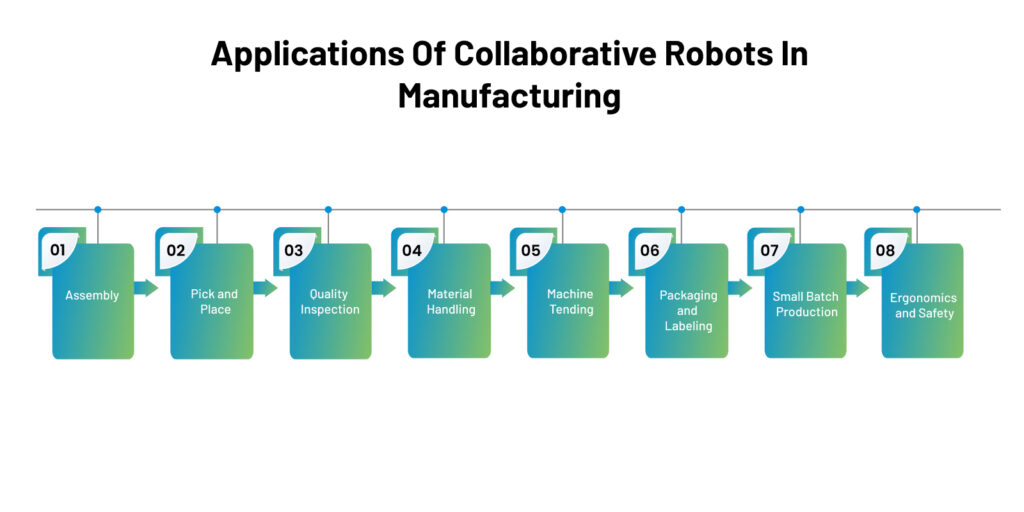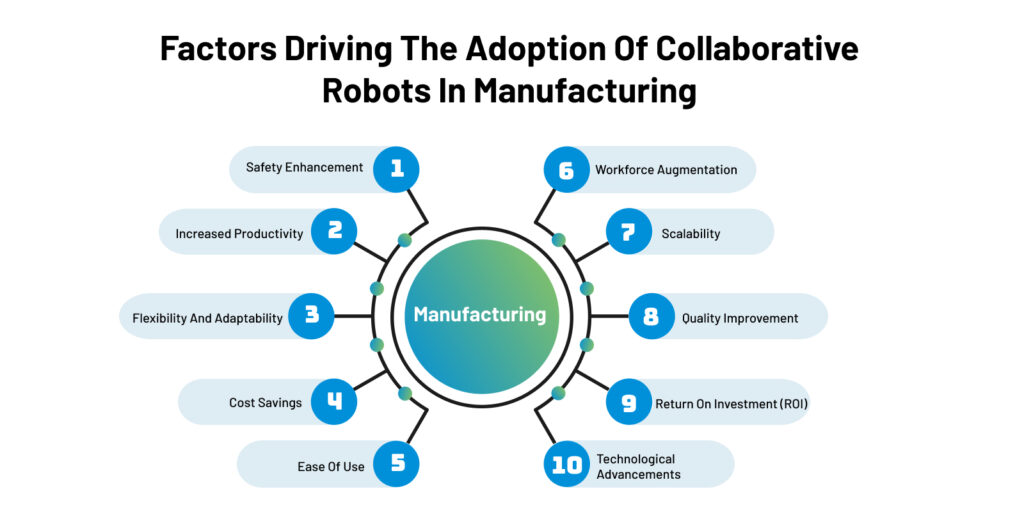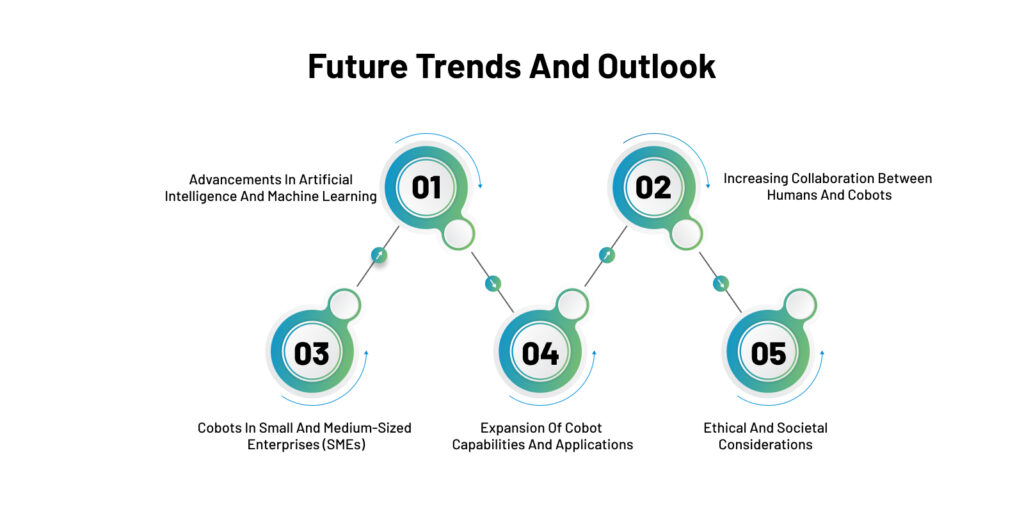In the manufacturing landscape, innovation is vital to staying ahead of the competition. The quest for increased efficiency, improved safety, and enhanced productivity have led to the rise of a remarkable technological advancement known as collaborative robots, or cobots. These intelligent machines have transformed manufacturers’ operations, offering a unique blend of automation and human interaction.
The growing adoption of cobots in Manufacturing is reshaping industries around the globe, revolutionizing production lines, and unlocking new possibilities. Gone are the days of the traditional industrial robot confined to cages, isolated from human workers. Cobots are designed to work alongside humans, complementing their skills and augmenting their capabilities.
This blog will explore the fascinating world of collaborative robots and the reasons behind their widespread adoption in the manufacturing sector. We will uncover the various benefits they bring, the diverse applications they are revolutionizing, and the factors driving their integration into production processes. Additionally, we will discuss the challenges manufacturers face when implementing cobots and examine real-life case studies of successful implementations.
So, if you’re curious about the future of Manufacturing and the game-changing impact of cobots, this blog is your gateway to understanding how these robotic co-workers are reshaping the industry. Let’s get started!
An Introduction to Cobots
In the fast-paced manufacturing world, where innovation reigns supreme, a new technological revolution is transforming the industry as we know it. Collaborative robots, often called cobots, have emerged as a game-changing force, revolutionizing production processes and addressing the evolving needs of manufacturers worldwide.
But what exactly are cobots? Unlike their traditional industrial robot counterparts, cobots are designed to work collaboratively with human operators, sharing the same workspace and undertaking tasks nearby. These intelligent machines are equipped with advanced sensors, vision systems, and adaptive algorithms, enabling them to interact and cooperate with humans safely and efficiently.
According to a recent study by Research Dive, the global collaborative robot market is projected to exceed a staggering $8,840.5 million by 2026, with a remarkable compound annual growth rate (CAGR) of 41.2%. This exponential growth signifies the increasing recognition and adoption of cobots in the manufacturing sector as industries seek to unlock their tremendous potential.
Manufacturing, with its complex and dynamic nature, is constantly evolving. Traditional assembly lines and processes often need help to keep up with the demands of modern production, leading to inefficiencies, safety concerns, and quality control issues. However, cobots have emerged as a transformative solution, offering a unique blend of automation, versatility, and human interaction.
These intelligent robots can perform various tasks, from assembly and material handling to quality inspection and packaging. By integrating cobots into manufacturing operations, companies are experiencing a myriad of benefits. Now what are these benefits? Let’s have a look.
Benefits of Collaborative Robots in Manufacturing
Collaborative robots, or cobots, have brought many benefits to the manufacturing industry. Their unique ability to work alongside human operators has revolutionized production processes, unlocking new possibilities and improving overall efficiency.

Increased Productivity: Cobots automate repetitive tasks, boosting productivity and throughput. Their precision and consistent performance optimize resource utilization, leading to faster production cycles.
Improved Worker Safety: Cobots have advanced safety features, detecting humans and adjusting movements to prevent accidents. Collaborating with cobots creates a safer environment, reducing the risk of injuries.
Enhanced Quality Control: Cobots perform tasks accurately, ensuring consistent product quality. With sensors and vision systems, they detect defects, conduct inspections, and make real-time adjustments.
Flexibility and Adaptability: Cobots can be easily reprogrammed and reconfigured for different tasks. This flexibility enables manufacturers to adapt quickly to changing production needs and varying market demands.
Cost-Effectiveness: Cobots are affordable, accessible to SMEs, and require minimal infrastructure modifications. They have low energy consumption, reduced maintenance needs, and offer a high ROI, contributing to cost savings and increased profitability.
Adopting collaborative robots in Manufacturing offers numerous benefits that contribute to increased productivity, improved worker safety, enhanced quality control, flexibility in operations, and cost-effectiveness. As the manufacturing industry embraces cobots, their positive impact on efficiency and profitability becomes increasingly evident. Cobots have undoubtedly become indispensable allies in pursuing excellence in the manufacturing realm.
Also, Read – Revolutionary Manufacturing Industry Solutions: The Digital Manufacturing Approach
Applications of Collaborative Robots in Manufacturing
Collaborative robots, also known as cobots, are designed to work alongside humans collaboratively. They offer a wide range of benefits in the manufacturing industry, revolutionizing how tasks are performed on the production floor. Here are some critical applications of collaborative robots in Manufacturing:

Assembly: Collaborative robots excel at repetitive and precise assembly tasks. They can work alongside human workers to perform tasks such as screwing, fastening, and component assembly. By automating these tasks, cobots enhance productivity, reduce errors, and free up human workers for more complex or strategic activities.
Pick and Place: Cobots can accurately pick objects from one location and place them in another. This capability is crucial for tasks like sorting, packaging, and palletizing in Manufacturing. Collaborative robots can work alongside human workers to handle repetitive, physically demanding, or monotonous pick-and-place tasks, reducing the risk of injuries and increasing efficiency.
Quality Inspection: Cobots can be equipped with advanced sensors, cameras, and vision systems to perform quality inspection tasks. They can quickly and accurately identify defects, measure dimensions, and check product inconsistencies. By automating quality inspection, cobots improve accuracy, speed up the process, and reduce the chances of human error.
Material Handling: Collaborative robots are ideal for material handling tasks such as transporting, loading, and unloading materials. They can efficiently move heavy or bulky objects, reducing the strain on human workers. Cobots can also navigate through complex environments, avoiding obstacles and ensuring the safe transportation of materials.
Machine Tending: In manufacturing processes that involve machines, cobots can be employed for machine tending. They can load raw materials into devices, unload finished products, and perform routine maintenance tasks. Collaborative robots can work close to machines, enhancing productivity, reducing downtime, and improving overall efficiency.
Packaging and Labeling: Cobots can automate packaging and labeling processes by placing products into packaging materials, sealing boxes, and applying labels. With their precision and speed, collaborative robots can significantly increase the speed and accuracy of packaging operations while reducing the risk of errors.
Small Batch Production: Collaborative robots are flexible and easily programmable, making them well-suited for small batch production or customized Manufacturing. They can quickly adapt to different product specifications, perform diverse tasks, and switch between production lines with minimal downtime.
Ergonomics and Safety: Another primary benefit of cobots is their ability to enhance workplace safety and ergonomics. Cobots reduce the risk of musculoskeletal disorders and other injuries associated with manual labor by automating repetitive or physically demanding tasks. Collaborative robots are designed with safety features such as force-sensing technology, collision detection, and speed limitations to ensure safe interaction with human workers.
Overall, the applications of collaborative robots in Manufacturing are diverse and continue to expand as technology advances. These cobots improve productivity, quality, and worker safety, enabling manufacturers to optimize their production processes and achieve greater efficiency.
Factors Driving the Adoption of Collaborative Robots in Manufacturing

Safety Enhancement: Collaborative robots, or cobots, are designed to work alongside humans, prioritizing safety. Their built-in sensors and advanced technologies enable them to detect and respond to human presence, reducing the risk of accidents and injuries in the manufacturing environment.
Increased Productivity: Collaborative robots can work efficiently and tirelessly without the need for breaks, resulting in increased productivity. They can perform repetitive tasks accurately and consistently, freeing human workers to focus on more complex and value-added activities.
Flexibility and Adaptability: Collaborative robots offer high flexibility in manufacturing processes. They can be easily programmed and reprogrammed to perform various tasks, making them suitable for small-batch production, frequent product changes, and customization. Their adaptability allows manufacturers to respond quickly to market demands.
Cost Savings: While initial investment costs may be higher than traditional industrial robots, collaborative robots offer long-term cost savings. They are generally more affordable to purchase and integrate into existing manufacturing systems. Additionally, cobots require minimal infrastructure changes, reducing installation and setup expenses.
Ease of Use: Collaborative robots are designed to be user-friendly, with intuitive programming interfaces that require minimal technical expertise. This ease of use enables rapid deployment and reduces the training time for operators, making them accessible to a broader range of manufacturing personnel.
Workforce Augmentation: Rather than replacing human workers, collaborative robots are designed to work alongside them, augmenting their capabilities. By automating repetitive and physically demanding tasks, cobots can alleviate worker fatigue, increase job satisfaction, and enable human workers to focus on higher-level skills, problem-solving, and innovation.
Scalability: Collaborative robots offer scalability options to manufacturers. They can be easily integrated into existing production lines and expanded as demand increases. This scalability allows manufacturers to adapt their operations efficiently and respond to market fluctuations or business growth.
Quality Improvement: Collaborative robots contribute to improved product quality through their precision and accuracy. By reducing human error and variability, cobots can enhance product consistency, minimize defects, and improve overall quality control in manufacturing processes.
Return on Investment (ROI): Adopting collaborative robots can lead to a significant return on investment. By improving productivity, reducing labor costs, and enhancing product quality, manufacturers can achieve a faster payback period and generate long-term cost savings, making cobots a financially viable investment.
Technological Advancements: Continuous advancements in robotics technologies, such as artificial intelligence, machine learning, and sensor technologies, are driving the adoption of collaborative robots in Manufacturing. These advancements enable cobots to perform more complex tasks, interact with humans more intelligently, and adapt to dynamic production environments.
These factors collectively contribute to the growing adoption of collaborative robots in the manufacturing industry, revolutionizing traditional production methods and fostering a new era of human-robot collaboration.
While adopting collaborative robots offers numerous benefits to the manufacturing industry, challenges and considerations must be addressed during implementation. Moving ahead, let’s look at the challenges.
Also, Read – Industry-Specific Challenges in Manufacturing: How to Overcome Them
Challenges and Considerations for Implementing Collaborative Robots

Risk Assessment and Safety Standards: Implementing collaborative robots requires a thorough risk assessment to identify potential hazards and ensure compliance with safety standards. Factors such as speed, force, and interaction with humans must be carefully evaluated to mitigate any risks to human workers.
Workforce Training and Acceptance: Training the existing workforce to operate and collaborate effectively with robots is crucial. Workers may need to acquire new skills to interact with cobots, program them, and troubleshoot any issues. Addressing any concerns or resistance from workers and fostering a culture of acceptance and collaboration is essential.
Integration with Existing Infrastructure: Collaborative robots must be seamlessly integrated into the existing manufacturing infrastructure. This may involve modifying workstations, redesigning processes, or implementing new communication systems to ensure smooth interaction between robots and other machines.
Cost-Benefit Analysis: While collaborative robots offer long-term cost savings, conducting a comprehensive cost-benefit analysis is essential. Factors such as upfront investment costs, maintenance expenses, and expected productivity gains should be carefully evaluated to determine the feasibility and financial viability of implementing cobots.
Task Suitability and Automation Potential: Not all tasks suit collaborative robots. Some processes may require high dexterity, decision-making, or human judgment, making automation challenging. It is crucial to identify jobs that align well with cobots’ capabilities and maximize their automation potential.
Scalability and Future Adaptability: When implementing collaborative robots, it is essential to consider scalability and future adaptability. As manufacturing needs evolve, the cobots should be capable of accommodating changes in production requirements, such as increased workload, new product lines, or process modifications.
Ethical and Legal Considerations: Integrating collaborative robots raises ethical and legal considerations. Questions surrounding job displacement, worker rights, data privacy, and liability in case of accidents or errors need to be addressed. Adhering to ethical guidelines and staying informed about legal frameworks is crucial for a successful implementation.
By addressing these challenges and considerations, manufacturers can effectively implement collaborative robots while ensuring human-robot collaboration’s safety, productivity, and acceptance in the manufacturing environment. But now that we know what benefits cobots offer and what challenges lie ahead of the manufacturing industry, it’s time to look into what the future holds for this technological advancement.
Future Trends and Outlook
Understanding future trends is crucial for manufacturers and industry professionals navigating the rapidly evolving landscape of collaborative robots (cobots) in Manufacturing. Anticipating future developments allows businesses to stay ahead of the curve, make informed decisions, and seize opportunities to maximize the benefits of cobot implementation while mitigating potential challenges.

Advancements in Artificial Intelligence and Machine learning:
One significant future trend is the continued advancements in artificial intelligence (AI) and machine learning (ML) technologies. These advancements will enhance the capabilities of cobots, enabling them to handle more complex tasks, learn from experience, and adapt to dynamic environments. AI and ML algorithms will allow cobots to make intelligent decisions, interact intuitively with humans, and optimize their real-time performance.
Increasing Collaboration between Humans and Cobots:
As cobot technology evolves, the collaboration between humans and cobots will intensify. Future developments will improve the interaction and communication between humans and cobots, allowing them to work together seamlessly as integrated teams. This collaborative synergy will lead to increased productivity, improved problem-solving abilities, and enhanced overall performance in manufacturing operations.
Cobots in Small and Medium-sized Enterprises (SMEs)
While cobots have gained significant traction in larger manufacturing enterprises, a future trend will be the broader adoption of cobots in small and medium-sized enterprises (SMEs). Technological advancements, cost reductions, and increased accessibility of cobots will make them more feasible for SMEs to implement. This expansion will democratize the benefits of cobot technology, empowering smaller businesses to enhance their productivity, competitiveness, and operational efficiency.
Expansion of Cobot Capabilities and Applications
Cobots are poised to expand their capabilities beyond their current applications. Future developments will witness cobots operating in diverse industries, performing a broader range of tasks, and collaborating with different types of machinery. Cobots will be increasingly integrated into logistics, healthcare, agriculture, and even personal assistance, unlocking new automation and human-robot collaboration opportunities.
Ethical and Societal Considerations:
As cobots become more prevalent in Manufacturing and society as a whole, ethical and societal considerations will come to the forefront. Discussions on the impact of automation on jobs, worker displacement, and socio-economic implications will gain prominence. Striking a balance between technological advancement and the well-being of individuals and society will be crucial for policymakers, organizations, and manufacturers.
Understanding future cobot trends and outlooks allows manufacturers to prepare for upcoming developments and make informed decisions.
Conclusion
The manufacturing industry is witnessing a transformative shift with the growing adoption of collaborative robots (cobots). These advanced machines, designed to work alongside humans, are revolutionizing traditional production methods and fostering a new era of human-robot collaboration.
The factors driving the adoption of cobots in Manufacturing are compelling. Safety enhancement ensures a secure working environment, while increased productivity and flexibility enable manufacturers to meet dynamic market demands efficiently. Cost savings, ease of use, and workforce augmentation further contribute to the appeal of cobots as valuable assets in the manufacturing landscape.
However, implementing cobots comes with its own set of challenges and considerations. Risk assessment, workforce training, integration with existing infrastructure, and cost-benefit analysis are crucial to ensure a successful cobot implementation. Furthermore, understanding task suitability and scalability and addressing ethical and legal considerations are vital for a harmonious collaboration between humans and cobots.
Future trends in AI and ML will further enhance cobot capabilities, paving the way for more complex tasks and seamless human-robot interaction. The increasing collaboration between humans and cobots will drive productivity and problem-solving to new heights. Moreover, the broader adoption of cobots in SMEs will democratize the benefits of this technology, leveling the playing field for businesses of all sizes.
The growing adoption of cobots in Manufacturing signifies a significant shift in production processes. By embracing the potential of collaborative robots and seeking valuable expertise from digital transformation consulting services to navigate this transformative landscape, manufacturers can unlock new productivity levels, improve product quality, and create safer working environments.
However, manufacturers must remain mindful of ethical and societal considerations as cobots evolve. Balancing technological advancements with the well-being of individuals and society is essential for ensuring a sustainable and inclusive future.




